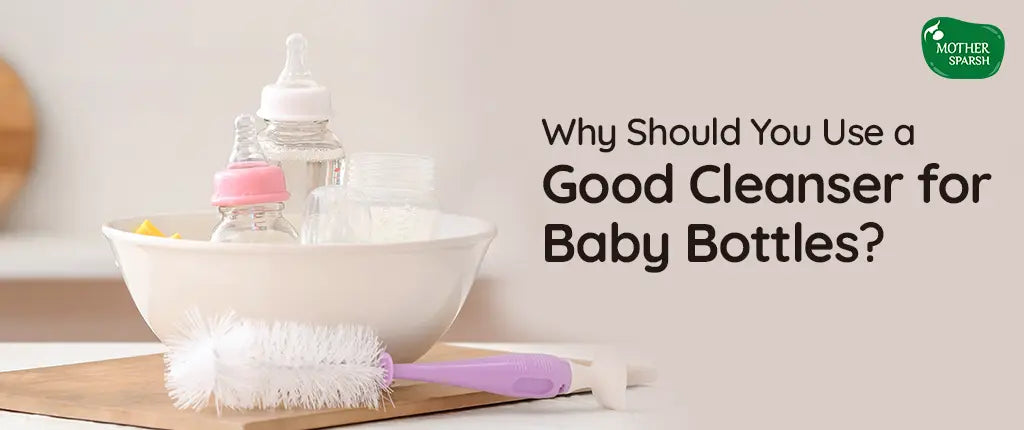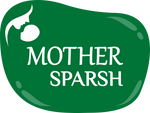
Why Should You Use a Good Cleanser for Baby Bottles?
Babies are delicate, and so is their immune system. It takes three months for babies to develop their immune system; therefore, they are at high risk of infections. That’s why they need extra care and hygiene. And when it comes to the bottles from which they are going to be fed six months after their introduction to the world, how can we take the risk of not cleaning them properly? No, not at all. That is why it is important to select the right baby liquid cleaner for your little one’s essentials!
Baby bottles, if not cleaned properly, can turn into breeding grounds for bacteria and other disease-causing germs. The sour milk odour you get every time you open the bottle and the oily-milky film inside it are signs of bacterial growth.
Studies even connect unhygienic baby bottles to health problems such as diarrhoea and asymptomatic enteric infections. Therefore, if you see any of these signs in your baby’s feeding bottle, it is high time you switch to the best liquid cleanser for baby bottles.

Why is there a need for a special liquid cleaner for babies?
Picking the right liquid baby cleanser for a baby bottle is as important as the cleaning itself.
It is no secret that regular cleaning liquids have highly concentrated surfactant-based chemicals, that might be harmful to your baby. So, make sure you use a baby bottle cleaner specifically formulated for infants.
However, considering the amount of options available in the market, it is essential to carefully choose liquid cleansers that are safe and made with natural ingredients.
You can check out Plant-Powered Natural Baby Liquid Cleanser from Mother Sparsh, which is the best for cleaning baby bottles. It removes up to 50% of the milk film and odour from baby bottles for safe and hygienic feeding. You can even use it to clean your little ones' pacifiers, toys and accessories as well.
What is cleanser, and why is it important?
Understanding what is cleanser is crucial for ensuring your baby's health. A cleanser is a specialized solution designed to effectively remove milk residues, bacteria, and other contaminants from baby bottles without leaving harmful residues. When considering how to clean baby bottles, using a proper cleanser ensures thorough sanitation and safety for your little one.
Why sterilise baby bottles?
Now that you know the importance of a special liquid cleanser, the next thing you would like to know is how to sterilise your little one’s feeding bottles.
Unsterilized baby bottles are a playground of germs and can cause several health issues for your baby. As your baby’s immune system is weaker than an adult's, their body might not resist these microbial infections.
A study published in the National Library of Medicine states that 91% of the sample baby bottles collected from a children’s hospital in Bangkok showed bacteria contamination. It also indicated that 70% of the bacteria in those bottles fall under 'enteric pathogens'.
● Enteric Infection
Enteric bacteria are bacteria present inside the guts of humans and animals and are usually harmless. However, there are pathogenic variants of enteric bacteria that produce toxins, leading to indigestion and other health issues.
Enteric infection is a health condition in babies that puts their lives at risk in the worst scenarios. Studies even link frequent subjection of enteric pathogens to stunted growth in children.
● Cronobacter Illness
Cronobacter illness is a rare yet harmful bacterial disease that can be transmitted through baby bottles. Cronobacter bacteria cause blood infections and meningitis in babies, which in severe cases can be fatal.
The good news is that the total number of Cronobacter illnesses reported every year is less than five. However, you still have to be careful about the formula milk you give your baby and the hygiene of the bottle.
How to clean baby bottles effectively?
Knowing how to clean baby bottles is essential for maintaining your baby's health. Begin by disassembling all parts of the bottle. Rinse each component under running water to remove any milk residue. Then, soak the parts in a basin filled with warm water mixed with a baby-specific cleanser. Use a bottle brush to scrub all areas, ensuring no residue remains. Rinse thoroughly and allow the parts to air dry on a clean surface.
How do I know if the baby bottle contains pathogens?
It is tough to understand whether harmful bacteria are in your baby’s bottle or not. Take the following signs as an indication of bacterial buildup in the baby bottle:
- Oily films inside the bottle.
- Icky milk odour.
- The transparent bottle is turning slightly opaque.
- Frequent digestive issues in babies.
If you see any of these signs, sterilise your baby’s bottle immediately to prevent further infection.
How do you sterilise baby bottles?
Stove top sterilisation
Sterilising baby bottles in a saucepan on the stovetop is one of the easiest and safest ways to ensure hygiene.
- Take a heavy-bottomed large saucepan (preferably steel) with water and bring it to a boil on the stovetop.
- Separate your baby bottle parts into top, bottom, nipple, and travel cap; wash all parts in the Mother Sparsh Plant-Powered Baby Liquid Cleanser.
- Immerse each cleansed part into the boiling water using a steel tong and let it boil for 3-5 minutes.
- Take out the parts carefully using the steel tong and keep them upside down on a dry kitchen towel. It will drain the water remaining inside the bottle and prevent moisture trapping.
Dishwasher Sterilisation
If you are using a glass baby bottle, the dishwasher is also a good option for sterilisation. Here is how you can do it:
- Open the bottle to separate each part and wash them in a plant-powered baby liquid cleaner.
- Keep the small parts, like the nipple and ring, on the top rack for the utensils or dishwasher-safe basket.
- Put the bottle in the rack for glass vessels to prevent breaking.
- Set the dishwasher on the sanitising cycle (you can also use a hot water cycle) and complete it with a heat dry.
- Take out the bottles after the cycles and keep them on a dry paper towel to remove the remaining moisture.
Microwave Sterilisation
Microwave is another simple method to sterilise your baby bottle; follow these methods for perfection:
- Clean the microwave with a cotton cloth to remove food debris from the oven.
- Wash baby bottles with a plant-powered baby liquid cleaner to remove milk remains
- Fill the bottle with water and microwave for 2-3 minutes at the highest temperature.
- Take out the bottles using oven mitts, remove the water, and keep them upside down on a dry paper towel to remove moisture content.
Buying the right baby care products is the first step to parenting; with Mother Sparsh by your side, you won’t have to go through the hassle of searching for the best product. Use the Plant-Powered Baby Liquid Cleanser to cleanse your baby’s feeding bottle, pacifier, toys, and other baby gears.
So, what are you waiting for? Order Today!

FAQ’s
Q1. Do you need to sanitise baby bottles after each use?
No, washing baby bottles with the Plant-Powered Baby Liquid Cleanser after every use and sanitising once every day is enough. However, we suggest you sanitise it before feeding the baby again if the baby is sick or the bottle is exposed to any unhygienic environment.
Q2. Why do my baby bottles have a film on them?
The fat content in milk leaves an oily film inside baby feeding bottles; the longer it stays there, the higher the chances of bacterial accumulation. Mother Sparsh Plant-Powered Baby Liquid Cleanser effectively removes up to 50% of the milky film to keep the bottle hygienic.
Q3. How do you get the milk odour off a baby bottle?
In order to remove the milk odour from the baby’s bottle, you should clean it properly with a natural liquid cleanser that is made with safe ingredients. You can try Mother Sparsh Liquid Baby Cleanser enriched with basil, green apple, and lemongrass which cleans up to 50% more milk odour from the baby bottles.
Q4. Is it okay to just rinse baby bottles?
No, it is not okay to just rinse your baby’s bottle. Unhygienic bottles can cause many harmful diseases for your baby. You should always wash your little ones’ feeding bottles with liquid bottle cleansers that are made with natural ingredients. Mother Sparsh plant-powered baby liquid cleanser helps clean and removes up to 50% more odour than ordinary cleansers.
Q5. Can I use regular dish soap for cleaning baby bottles?
You can use regular dish soap, but it is better to use liquid baby bottle cleaners that are free from any harmful chemicals and artificial fragrances that can disturb a baby’s delicate immune system.
Schema





